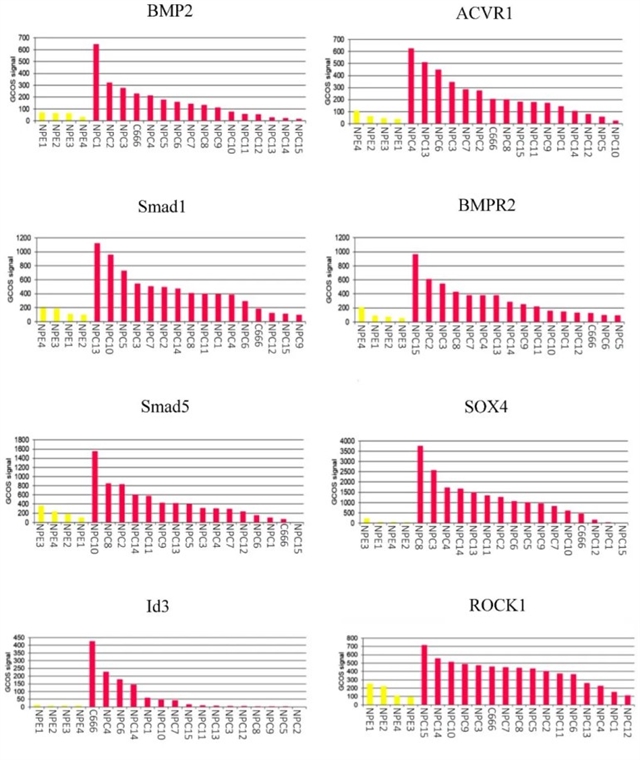|
|
|
|
|
与癌有关?EB病毒不无辜!| MDPI Pathogens |
|
|
论文标题:The Epstein-Barr Virus-Encoded EBNA1 Protein Activates the Bone Morphogenic Protein (BMP) Signalling Pathway to Promote Carcinoma Cell Migration
期刊:Pathogens
作者:Hannah E. Bridgewater, Kathryn L. Date, John D. O’Neil, Chunfang Hu, John R. Arrand, Christopher W. Dawson and Lawrence S. Young
发表时间:21 July 2020
DOI:10.3390/pathogens9070594
微信链接:
https://mp.weixin.qq.com/s?__biz=MzI1MzEzNjgxMQ==&mid=2649979381&idx=3&sn=
4efabe2108ccf74aa28e721bafdcafad&chksm=f1dec331c6a94a273416a32461828fd68d6
72a61ee18cacf180dd892f794477e8d855fa58066&token=940521072&lang=zh_CN#rd
期刊链接:https://www.mdpi.com/journal/pathogens
爱泼斯坦-巴尔病毒
爱泼斯坦-巴尔病毒 (Epstein-Barr virus, EBV) (简称:EB病毒) 由Michael Anthony Epstein和Yvonne Margaret Barr于1964年发现,此病毒在世界各地广泛传播,造成95%以上的成年人口感染,因此又被称为“人人病毒”[1]。Michael Anthony Epstein和Yvonne Margaret Barr等人在非洲的伯基特淋巴瘤 (Burkitt lymphoma, BL) 中分离出了EB病毒,由此证明EB病毒与伯基特淋巴瘤有关,这是第一个被发现与人类肿瘤相关的病毒。此后的研究进一步表明EB病毒与传染性单核细胞增多症、T细胞淋巴瘤、成人T细胞白血病、自然杀伤 (Natual Killer, NK) 细胞白血病、移植后淋巴增生性疾病、鼻咽癌以及各种其他淋巴样和上皮恶性肿瘤有关。
EB病毒是如何导致恶性癌症的?
EB病毒是第一个被发现与人类肿瘤发生有关的病毒,属于疱疹病毒科嗜淋巴细胞病毒属,且是该亚科中能够感染人类的淋马滤泡病毒。该病毒为双链DNA病毒,具有在体内外专一性地感染人类及某些灵长类B细胞的生物学特性。人类作为EB病毒感染的宿主,主要的传播方式为唾液传播,也可通过血液或性途径传播[2]。但是,EB病毒是如何导致恶性癌症的呢?它的促癌机制又是如怎样的呢?这也是众多肿瘤研究者关注的课题。
英国华威大学Lawrence S. Young教授及其团队在Pathogens期刊发表的文章“The Epstein-Barr Virus-Encoded EBNA1 Protein Activates the Bone Morphogenic Protein (BMP) Signalling Pathway to Promote Carcinoma Cell Migration” (爱泼斯坦巴尔病毒编码的EB病毒核抗原1 (EBNA1) 能通过骨形态发生蛋白信号通路来加快癌细胞转移) 中,揭秘了EB病毒是如何利用骨形态发生蛋白 (Bone Morphogenic Protein, BMP) 成为恶性肿瘤的元凶。
骨形态发生蛋白信号通路在阳性鼻咽癌中表达异常活化
为了获得BMP通路活性在阳性鼻咽癌 (Nasopharyngeal Carcinoma, NPC) 中的整体印象,作者使用dChip软件分析归一化阵列强度,并使用R Studio生成与BMP通路相关的差异调控基因的热图。作者将来自16个真实的显微切割的NPC肿瘤 (图1,粉红色) 以及C666-1 NPC细胞系的阵列强度与4个正常的鼻咽上皮样品 (图1,黄色) 进行比较。作者发现,相对于正常组织,大量BMP途径成分和靶标上调,表明NPC肿瘤和C666-1细胞系中BMP信号传导途径的整体活化。

图1. GeneChip®操作软件分析证实,EB病毒阳性NPC肿瘤中所选取的关键DMP成分的总体表达高于鼻咽上皮细胞。BMP2的平均倍数增加了2.4倍、ACVR1增加了5.2倍、Smad1增加了5.1倍、BMPR2增加了5.8倍、Smad5增加了2.4倍、SOX4增加了14.3倍、Id3增加了1.85倍、以及ROCK1增加了2.24倍。
在EB毒核抗原1的Ad/AH细胞中,与骨形态发生蛋白通路相关基因的基因表达谱
为确定EB病毒对骨形态发生蛋白通路的影响是否是由病毒编码的EB病毒核抗原1蛋白引起的,作者通过现有的Affymetrix基因表达阵列数据的分层聚类分析法,分析了稳定表达爱泼斯坦病毒核抗原1中的爱泼斯坦病毒阴性的Ad/AH癌细胞和亲代Ad/AH细胞系数据,得到了与骨形态发生蛋白途径相关基因差异调控的大体观点。差异调节基因的合成热图由dChip软件生成 (图2)。大量上调基因 (红色) 表明爱泼斯坦病毒核抗原1参与激活骨形态发生蛋白信号通路。

图2. 稳定表达爱泼斯坦病毒核抗原1的Ad / AH细胞系中,骨形态发生蛋白相关基因的基因表达谱。大量文献检索揭示了一组与骨形态发生蛋白信号通路相关的基因。利用生成的基因列表来鉴定重要差异调节基因,再用另一项从稳定表达爱泼斯坦病毒核抗原1的Ad/AH细胞和亲代Ad/AH细胞中生成的表达阵列数据,用dChip软件对所有数据进行可视化,用于层次聚类分析。每个基因在单个样品中的表达水平用颜色区分:蓝色代表下调,红色代表上调,白色代表不变。
实验结论
在该项实验中,作者通过观察EB病毒核抗原1在EB病毒中的表达,首次证明了EB病毒潜伏感染癌细胞导致骨形态发生蛋白的诱导与BMP通路的组成性激活。与此同时,作者也进一步揭示了BMP中转化生长因子 (Transforming growth factor beta, TGFβ) 的通路失调与EB病毒相关癌症的病因有关,并强调了病毒编码蛋白在中间起的作用。
此次研究数据增加了对致癌γ-疱疹病毒、EB病毒和卡波氏肉瘤相关疱疹病毒 (Kaposis Sarcoma-associated Verpesvirus, KSHV),篡夺BMP-SMAD信号通路、促进细胞转化和增强细胞运动这些普遍现象的了解。更重要的是,EB病毒核抗原1可能会利用BMP信号的特定方面来促进EB病毒相关恶性肿瘤的进展,这为治疗干预提供了一个有趣的潜在靶点。
参考文献
1. Andersson, J. An Overview of Epstein-Barr Virus: from Discovery to Future Directions for Treatment and Prevention. Herpes. 2000, 7, 76-82.
2. Epstein-Barr virus (EBV). Available online: https://www.cancer.org/cancer/cancer-causes/infectious-agents/infections-that-can-lead-to-cancer/viruses.html (accessed on 25 December 2020)
Pathogens (ISSN 2076-0817; IF 3.108) 是国际同行评审的开放获取期刊。期刊涵盖有关病原体和病原体-宿主相互作用的所有方面的研究。Pathogens采用单盲同行评审,一审周期约为14.1天,文章从接收到出版只需2.5天。
Background
The Epstein-Barr virus (EBV)-encoded nuclear antigen 1 (EBNA1) protein is expressed in all virus-associated malignancies, where it performs an essential role in the maintenance, replication and transcription of the EBV genome. In recent years, it has become apparent that EBNA1 can also influence cellular gene transcription. Here, we demonstrate that EBNA1 is able to stimulate the expression of the Transforming growth factor-beta (TGFβ) superfamily member, bone morphogenic protein 2 (BMP2), with consequential activation of the BMP signalling pathway in carcinoma cell lines. We show that BMP pathway activation is associated with an increase in the migratory capacity of carcinoma cells, an effect that can be ablated by the BMP antagonist, Noggin. Gene expression profiling of authentic EBV-positive nasopharyngeal carcinoma (NPC) tumours revealed the consistent presence of BMP ligands, established BMP pathway effectors and putative target genes, constituting a prominent BMP “signature” in this virus-associated cancer. Our findings show that EBNA1 is the major viral-encoded protein responsible for activating the BMP signalling pathway in carcinoma cells and supports a role for this pathway in promoting cell migration and possibly, metastatic spread.
Results
While at present, the interaction of viral proteins with the BMP signalling pathway has not been widely examined in the context of virus-associated malignancies, one study has reported the ability of the hepatitis B virus-encoded oncoprotein pX to activate BMP2-induced transcription in vivo, providing a potential contributory factor to hepatitis B virus-induced liver fibrosis. More recently, the Kaposi’s sarcoma herpes virus (KSHV)-encoded nuclear protein, LANA, a functional homologue of EBNA1, has been shown to bind SMAD1 and to induce BMP signals in the absence of a ligand. Interestingly, the induction of Id1, a BMP-SMAD1 target protein, was shown to be important for LANA-mediated transformation of endothelial cell lines. Our data add to the general phenomenon that the oncogenic γ-herpesviruses, EBV and KSHV, usurp the BMP-SMAD signalling pathway to promote cell transformation and enhance cell motility. Our study demonstrates that EBNA1, like LANA, may commandeer specific facets of BMP signalling to advance the progression of EBV-associated malignancies providing an interesting potential target for therapeutic intervention.
Conclusions
Our study identified the presence of a prominent BMP “signature” in EBV-positive NPC, suggesting that aberrant BMP activation may contribute to the aetiology of this virus-associated cancer. Importantly, we showed that the genome maintenance protein, EBNA1, is the major viral-encoded protein responsible for activating the BMP pathway, through a mechanism involving autocrine induction of a BMP ligand. Collectively, this study supports a role for the BMP pathway in promoting cell migration and possibly, metastatic spread of this cancer.


(来源:科学网)
特别声明:本文转载仅仅是出于传播信息的需要,并不意味着代表本网站观点或证实其内容的真实性;如其他媒体、网站或个人从本网站转载使用,须保留本网站注明的“来源”,并自负版权等法律责任;作者如果不希望被转载或者联系转载稿费等事宜,请与我们接洽。